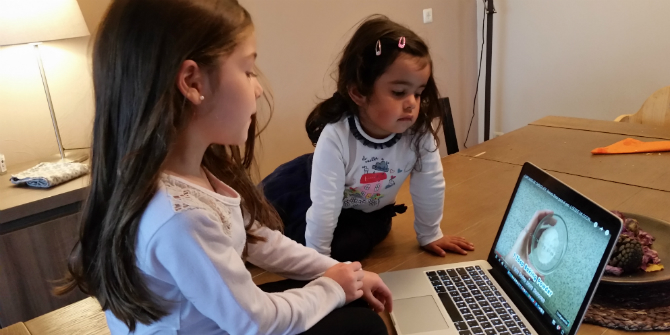 A survey of Italian mothers who engage in ‘sharenting’ suggests they are motivated by both a desire for external validation, as well as more communitarian goals such as sharing moments with distant relatives and seeking support. But while many mothers see it as their right to engage in sharenting, what implications does this have for children’s rights and privacy? Davide Cino is a PhD student studying education in contemporary society at the University of Milano-Bicocca and a visiting pre-doctoral Fellow at Northwestern University. He researches children’s social media presence and online privacy. Silvia Demozzi, PhD, is a researcher in education at the University of Bologna. Her work focuses on child adultisation and sexualisation, sharenting and children’s rights. [Header image credit: Michael Morse for Pexels]
A survey of Italian mothers who engage in ‘sharenting’ suggests they are motivated by both a desire for external validation, as well as more communitarian goals such as sharing moments with distant relatives and seeking support. But while many mothers see it as their right to engage in sharenting, what implications does this have for children’s rights and privacy? Davide Cino is a PhD student studying education in contemporary society at the University of Milano-Bicocca and a visiting pre-doctoral Fellow at Northwestern University. He researches children’s social media presence and online privacy. Silvia Demozzi, PhD, is a researcher in education at the University of Bologna. Her work focuses on child adultisation and sexualisation, sharenting and children’s rights. [Header image credit: Michael Morse for Pexels]
Parents are active users of digital technology and social media, with mothers being more likely to seek and receive support online. According to Alicia Blum-Ross and Sonia Livingstone, ‘sharenting’ is the act of “sharing representations of one’s parenting or children online”. We studied sharenting among a sample of 216 Italian mothers recruited through Facebook groups for parents (FGP) or parents’ personal Facebook pages. We used the metaphor of the ‘showcase‘ as a ‘stage’ where people can narrate their lives.
Multiple showcases
Living in a showcase is not new. If anything, what is new is the progressive dematerialisation and virtualisation of the present. Looking at our evolution as human beings, the metropolis can be seen as a good starting point to describe how both children and adults started to present themselves in front of an audience they were also part of. Then there was (and still is) the stage, a showcase where individuals, including children and their bodies, can be represented.
Today, social networking sites play this role, allowing people to show off their lives and the roles they play in society and providing users with the opportunity to share worries, doubts and questions concerning daily problems, as well as display achievements and receive feedback. Showcasing one’s life also comes with some implications: constant opportunities for social comparison; different concerns about privacy; the risk of believing that the way we see the world around us, filtered by a screen, reflects reality as it is.
Sharenting as a form of “social showcasing”?
To different extents, all of the above applies to parenting too. In the era of intensive parenting and the mommy myth, social media use could in fact intensify FoMO Parenting. Parents risk normalising unrealistic expectations and thinking they can be held accountable for all of their children’s achievements or failures in life. However, as social scientists, we should stress that in spite of the fact that a good family environment is considered to be linked to positive outcomes in life, it is not the only variable to bear in mind when it comes to children’s development. There is a whole world around us that sends messages about what a good parent should or should not be. This is particularly true in the era of digital technology, where the amount of information can be overwhelming.
On another note, showcasing one’s parenting online can involve the use of various self-presentation strategies. When sharing about their children, parents may engage in indirect impression management and altercasting, with children’s representation becoming a litmus test of mothering. Additionally, parents are their offspring’s personal information gatekeepers. As a result, questions may arise about whose story is being told and what happens to children’s rights in the digital age.
Italian mothers and Sharenting: from a Facebook group for parents to personal Facebook pages
An exploratory survey of a non-probabilistic sample of 216 Italian mothers who responded to an advert on a major Italian Facebook group for parents, and a parenting blog, was carried out. The voluntary respondents were mostly aged 30-40 (58%), were generally well educated, holding in most cases a degree or a high school diploma, and were in employment. Because our sampling was conducted via online communities for parents, the fact that respondents were using such sites, either as members or observers, and voluntarily completing the survey, probably shows a pre-existing involvement with the matters being discussed.
Unsurprisingly, we found a majority of mothers (89%) were a member of at least one Facebook group for parents (FGP), especially if they had a child aged 0-3. These groups are often part of one’s daily routine (59%), and are considered to be useful in making parents feel less alone and expanding one’s network, as well as providing parenting and pediatric information.
Our respondents also reported posting pictures of their children on their personal Facebook pages (68%), with 62% sharing at least one to four photos a month. Mothers who were pleased to receive ‘likes’ for such pictures (81%) shared more pictures than those who were indifferent. Although receiving external validation through ‘likes’ was shown to reinforce the likelihood they would post photos of their offspring again, several respondents highlighted the communitarian aspect of this practice: sharing happy and important, as well as sad and difficult, moments with a broader community, including relatives and friends living far away.
Privacy settings were used most of the time (88%), with 83% of respondents sharing only with ‘friends’. However, 88% of mothers who share photos stated they had never notified their children before posting photos of them on Facebook, and 38% had never consulted their partner. Mothers who share were more likely to consider sharenting as the right of a parent compared to those who don’t post about their kids (87% vs. 47%). On the other hand, 99% of mothers who do not share agreed that this could be an early exposure of the child to the internet and the associated risks. Interestingly, such a position was also sustained by mothers who share (62%), and they were found to post less than those who disagreed with it. This suggests that mothers concerned about their children’s online exposure may regulate their photo-sharing behaviour accordingly.
To share or not to share? This is not the only question
We found that mothers consider FGPs useful in order to feel less alone and receive support. We wonder whether, as members of an individualistic culture, we are not giving them the right support to cope with parenting challenges. Or are they demonstrating agency by using technology to tackle daily problems? How can we foster a sense of belonging within society as a whole while promoting a digital-savvy approach to technology and social media?
If, as argued, we are living in an era of ‘social showcasing’, exposing one’s life online will probably sound natural. Mothers who share are more likely to see this as their right, but when does this right end online? In line with the privacy/openness paradox, most of our respondents recognised that sharenting may be risky, and this probably led them to post less. However, deeper reflection on the reasons behind sharing, as well as what is being shared (not only “how much”), is required to promote safe practices and tackle the publicity vs. privacy dilemma.
Finally, given the power of the ‘like’, how parents may interpret this cue when sharing about their children is another question to be addressed. But, as our data suggests, framing sharenting only as a form of digital narcissism is not sufficient.
When considered under a communitarian light, according to Dunbar’s number, 150 is the number of close relationships one can handle offline and online, with 15 best friends. Italian users have an average of 300 Facebook friends each, which poses the question of whether the audience parents share pictures of their children with mirrors the number of important people they are happy to keep updated on their offspring’s life. Thus, future studies may want to consider more in depth how such an audience is imagined and managed by parents.
Conclusions
In this digital age, reflecting on how to promote digital citizenship is certainly pivotal to respecting children’s rights online and offline. However, giving instructions is far from our intention. Families are not islands, but active members of a larger social system. A broader and deeper reflection is required in order not to underestimate how, without even knowing it, using a connotative language can have an impact on the world we live in, framing parents as ‘good’ or ‘bad’ according to their online behaviour. What are, in turn, the social and historical roots of sharenting? And how does such a practice contribute to the biggest narrative of parenting in the neoliberal age?
This post represents the views of the authors and not those of the LSE Parenting for a Digital Future blog nor of the London School of Economics and Political Science.





